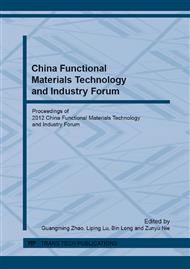p.701
p.707
p.713
p.718
p.723
p.727
p.734
p.739
p.743
Research of the Ancient Sea Rock-The Natural Mineral Enzyme Function Water
Abstract:
In this paper, the micro-nanopowder of ancient Sea rock was used as core material to filter tap water. With this method, the healthy-drinking water has been prepared successfully with the property of weak alkaline, small molecule clusters, rich of trace elements contributing to health. Its properties were characterized by high-resolution superconducting NMR spectrometer, inductively-coupled plasma spectrometer, far infrared radiation rate tester, pH acidity meter and redox potential instrument. The results showed that the pH value of this water was 7.2~7.8, and the region of ORP was 124mV; FWHM of 17O-NMR spectrum was 56.39Hz, It is a kind of water with small molecules; It also contains a variety of macro and micro elements which human needed; The filtered water is beneficial to human health and longevity with a good immune function. Keywords: Ancient Sea rock, Function water, Health, Longevity;
Info:
Periodical:
Pages:
723-726
Citation:
Online since:
May 2013
Authors:
Keywords:
Price:
Сopyright:
© 2013 Trans Tech Publications Ltd. All Rights Reserved
Share:
Citation:


